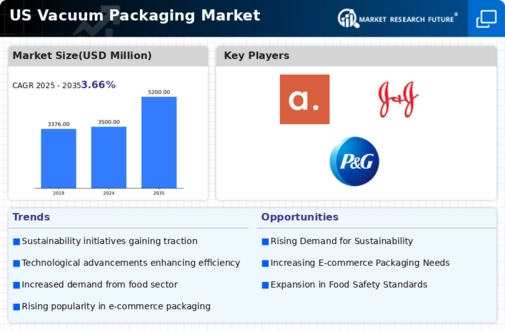Rising Demand for Convenience Foods
The vacuum packaging market is experiencing a notable surge in demand for convenience foods, driven by changing consumer lifestyles. As more individuals seek quick meal solutions, the need for products that maintain freshness and extend shelf life becomes paramount. In 2025, the convenience food sector is projected to reach approximately $100 billion in the US, with vacuum packaging playing a crucial role in preserving the quality of these products. This trend indicates a shift towards ready-to-eat meals and snacks, which are often packaged using vacuum technology to enhance longevity. Consequently, manufacturers are increasingly investing in vacuum packaging solutions to cater to this evolving consumer preference, thereby propelling growth within the vacuum packaging market.
Growth in E-commerce and Online Retail
The vacuum packaging market is significantly influenced by the rapid expansion of e-commerce and online retail platforms. As consumers increasingly turn to online shopping for food and other products, the demand for effective packaging solutions that ensure product integrity during transit is rising. In 2025, e-commerce sales in the food sector are expected to exceed $30 billion in the US, necessitating robust packaging methods. Vacuum packaging is particularly advantageous in this context, as it minimizes spoilage and enhances product presentation. This trend suggests that companies are likely to adopt vacuum packaging technologies to meet the logistical challenges posed by online sales, thereby driving growth in the vacuum packaging market.
Rising Awareness of Food Waste Reduction
the vacuum packaging market is increasingly influenced by the growing awareness of food waste reduction.. Consumers and businesses alike are recognizing the environmental and economic impacts of food waste, prompting a shift towards more sustainable practices. In 2025, the food waste management market is projected to reach $50 billion in the US, highlighting the urgency of addressing this issue. Vacuum packaging is an effective method for extending the shelf life of perishable goods, thereby reducing waste. This trend suggests that as awareness continues to rise, more companies will adopt vacuum packaging solutions to align with sustainability goals, ultimately driving growth in the vacuum packaging market.
Increased Focus on Food Safety Regulations
The vacuum packaging market is being shaped by heightened awareness and enforcement of food safety regulations. Regulatory bodies in the US are implementing stricter guidelines to ensure food quality and safety, which directly impacts packaging practices. In 2025, the food safety compliance market is projected to grow by 15%, reflecting the increasing importance of adhering to these regulations. Vacuum packaging is recognized for its ability to reduce the risk of contamination and extend shelf life, making it a preferred choice among food manufacturers. This regulatory landscape compels businesses to invest in vacuum packaging solutions, thereby fostering growth within the vacuum packaging market.
Technological Innovations in Packaging Solutions
The vacuum packaging market is benefiting from ongoing technological innovations that enhance packaging efficiency and effectiveness. Advances in materials and machinery are enabling manufacturers to produce more sustainable and user-friendly vacuum packaging solutions. In 2025, the market for advanced packaging technologies is anticipated to grow by 20%, indicating a strong trend towards innovation. These developments not only improve the performance of vacuum packaging but also align with consumer preferences for eco-friendly options. As companies strive to differentiate their products in a competitive landscape, the adoption of innovative vacuum packaging technologies is likely to accelerate, contributing to the expansion of the vacuum packaging market.














Leave a Comment